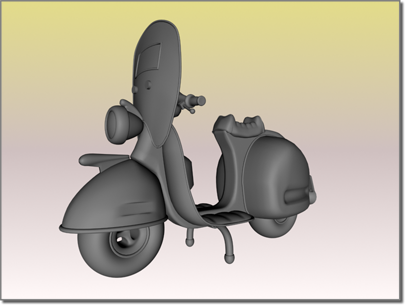The Standard material type provides a fairly straightforward way to model surfaces. In the real world, the appearance of a surface depends on how it reflects light. In 3ds Max, a standard material simulates a surface's reflective properties. If you don't use maps, a standard material gives an object a single, uniform color.

Scooter rendered with the default standard material
This topic introduces the controls for Standard material, exclusive of the use of maps.
A surface of a "single" color usually reflects many colors. Standard materials typically use a four-color model to simulate this. (This can vary, depending on which shader you use.) The four colors are known as the material’s color components.
This component is called "diffuse" because light striking it is reflected in various directions. Highlights, on the other hand, are reflections of light sources.
A surface can also have glancing highlights, where the angle of incidence is high, relative to the observer or camera (that is, the light ray is nearly parallel to the surface). Glancing highlights are characteristic of metallic surfaces.
Some surfaces are completely reflective, or nearly so. These reflect their environment as well as the light sources that illuminate them. To model such surfaces, you need to assign a Reflection map or use ray tracing.
The Filter color component isn't visible unless the material's Opacity is less than 100 percent.
The three color components blend at the edges of their regions. Between ambient and diffuse, the blending is calculated by the shader. Between diffuse and specular, you set the amount of blending by using the Standard material's highlight controls.
When we describe an object's color in conversation, usually we mean its diffuse color. The choice of an ambient color depends on the kind of lighting. For moderate indoor lighting, it can be a darker shade of the diffuse color, but for bright indoor lighting and for daylight, it should be the complement of the primary (key) light source. The specular color should be either the same color as the key light source, or a high-value, low-saturation version of the diffuse color.
For more tips on choosing color components, see Choosing Colors for Realism.
Other Standard Material Components
A standard material's specular color appears in highlights. You can control the size and shape of the highlight. A polished surface has a small and strong highlight. A matte surface has a large, weak highlight, or no highlight at all.
Standard materials also have controls for making the object appear transparent, and for making it self-illuminating so that it appears to glow.
Along with the material's color components, components also refers to the parameters that control highlights, transparency, self-illumination, and so on.
Materials add greater realism to a scene only if you choose their colors and other properties to appear like real-world objects. This topic presents some general guidelines for choosing standard material colors. When possible, you should also observe colors in the objects you are modeling, especially under different lighting conditions.
The Shader Basic Parameters rollout lets you choose the type of shader to use with a Standard material. Some additional controls affect how the material appears.
The Basic Parameters rollouts for Standard materials contain controls that let you set the color of your material, the shininess, the transparency, and so on, and specify maps to use for the various components of the material.
The Extended Parameters rollout is the same for all shading types of Standard material, with the exception of the Strauss and Translucent shaders, as noted below. It has controls related to transparency and reflection, as well as options for Wire mode.
A material's Maps rollout lets you access and assign maps to various components of the material. It also lets you set an Amount value (relative strength) for each map.